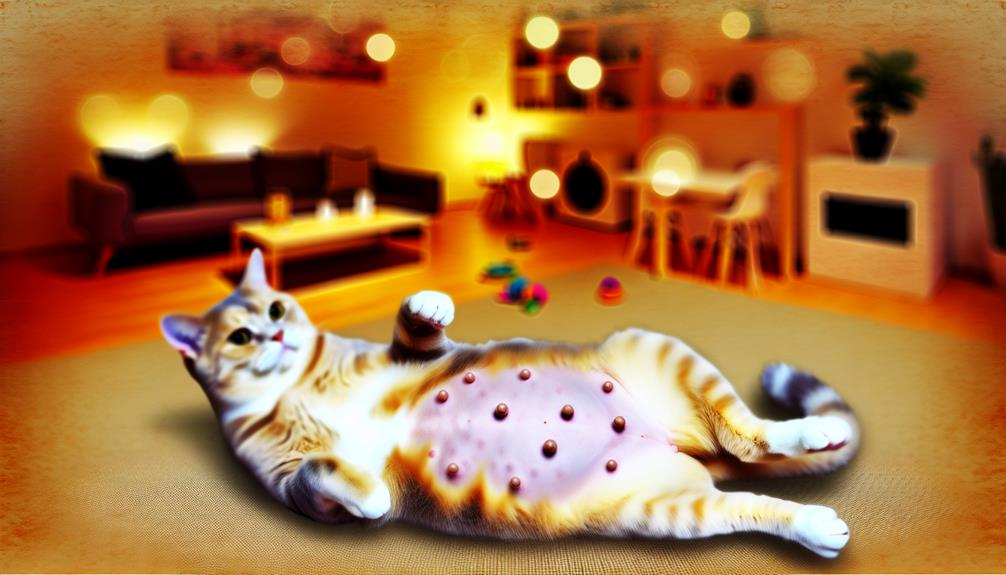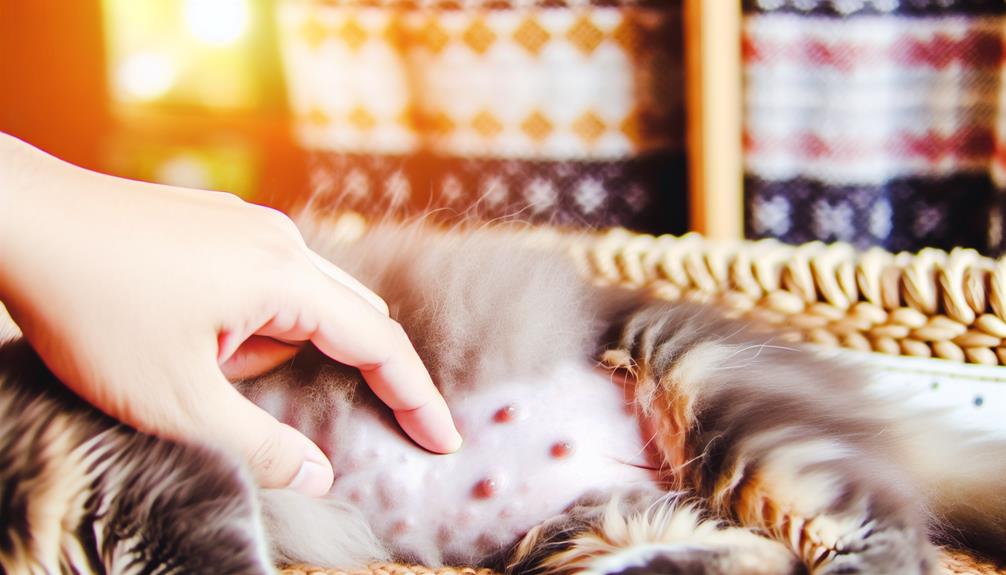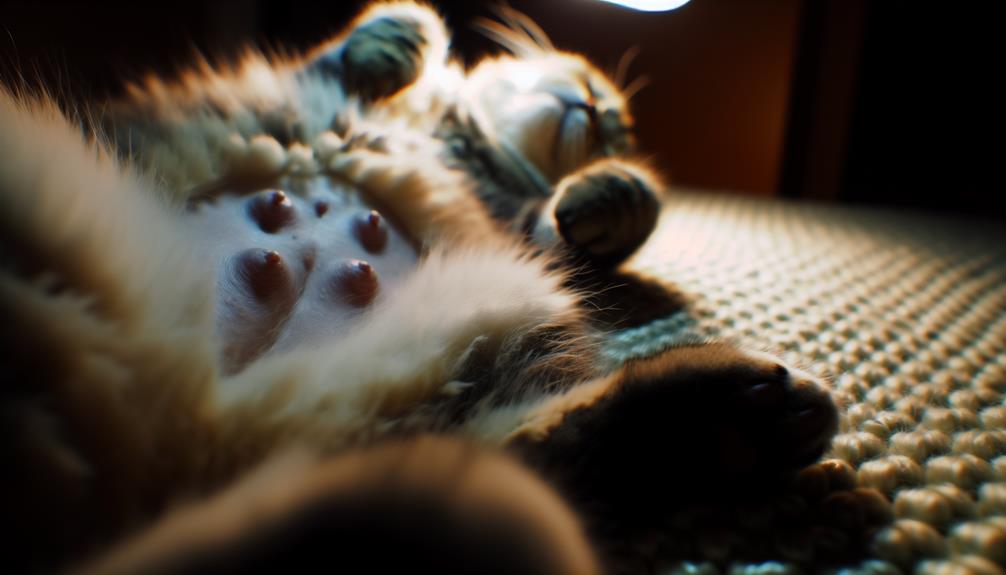Did you know that nearly 100% of male cats have nipples, even though they serve no functional purpose? It's a fascinating aspect of feline anatomy that many people don't realize. You might wonder why male cats have these vestigial traits and if they could potentially lead to health issues. Understanding the evolutionary background and common misconceptions about male cat nipples can offer valuable insights. So, what should you be aware of when it comes to checking your male cat's health? There's more to uncover in this intriguing aspect of your pet's biology.
The Basics of Cat Anatomy
Understanding the basics of cat anatomy is essential for comprehending whether male cats have nipples. In feline physiology, both male and female cats share a fundamental anatomical structure. Cats, regardless of gender, possess a mammalian body plan that includes key components such as the skeletal system, musculature, and various organs. This shared structure extends to the integumentary system, which encompasses the skin and its appendages, including fur, claws, and nipples.
In cat anatomy, nipples are arranged bilaterally along the ventral surface of the abdomen. Typically, cats have between six to eight nipples, although this number can vary. These nipples are present from birth in both males and females because they develop from the same embryonic tissues. Specifically, the mammary ridges, also known as milk lines, form early in embryonic development and give rise to nipples in both genders. This is a critical aspect of feline physiology that explains why male cats possess nipples.
Examining the role of these structures, it's clear that in female cats, nipples are functional and linked to the mammary glands, which produce milk for nursing kittens. In male cats, however, the nipples are non-functional and do not connect to mammary glands. Their presence is a vestigial trait, meaning they remain from a developmental phase but do not serve a reproductive function in males.
Thus, a thorough understanding of cat anatomy and feline physiology reveals that male cats do indeed have nipples, a shared characteristic rooted in their mammalian development.
Evolutionary Background
From an evolutionary standpoint, the presence of nipples in male cats can be traced back to the shared ancestry of all mammals. Mammary glands, and by extension nipples, develop early in embryonic stages before the differentiation of sexual characteristics. This stage occurs prior to the establishment of sexual dimorphism, which is the distinct difference in appearance or physiology between sexes of the same species.
Nipples are formed during the early stages of mammary development, a process regulated by a series of genetic and hormonal signals. These signals are not sex-specific initially, which is why both male and female embryos develop nipples. The genes responsible for this early development are highly conserved across mammalian species, reflecting a common evolutionary blueprint.
In male cats, the presence of nipples serves no functional purpose post-birth, given that mammary glands do not develop further without the influence of female-specific hormones such as estrogen and progesterone. However, the evolutionary cost of having non-functional nipples in males is negligible. Evolution tends to favor the retention of structures that do not negatively impact an organism's fitness, explaining why these vestigial structures persist in male cats.
Sexual dimorphism becomes more evident as the organism matures, driven by the hormonal changes that differentiate males from females. Nonetheless, the initial stages of development, which include the formation of nipples, remain largely similar across sexes. This evolutionary remnant underscores the shared developmental pathways that all mammals, including cats, undergo. Consequently, while male nipples may seem redundant, they are a reflection of the common mammalian heritage and the intricacies of evolutionary biology.
Common Misconceptions

While the evolutionary explanation for the presence of nipples in male cats is well-grounded, it's important to address some common misconceptions surrounding this anatomical feature. Many people mistakenly believe that nipples serve a significant function in male cats, similar to their role in females. However, in males, the nipple function is largely vestigial, meaning it doesn't serve a critical purpose in their physiology. This misunderstanding can often lead to unnecessary concern or confusion among pet owners.
Gender stereotypes further complicate the matter. Society often imposes human gender norms onto animals, assuming that certain traits or characteristics are exclusively female or male. This can lead to the erroneous belief that only female cats possess nipples, which isn't the case. Both male and female cats develop nipples due to shared embryonic pathways, a process that occurs before the differentiation of sexual characteristics.
To clarify, consider these common misconceptions and their emotional impact:
- Concern: "Does my male cat having nipples mean something's wrong?" The answer is no, it's completely normal.
- Confusion: "I thought only female cats had nipples." This stems from applying human gender stereotypes to animals.
- Curiosity: "What purpose do male cat nipples serve?" In males, the nipple function is mostly redundant, unlike in females where it plays a role in nursing.
Understanding these points helps dispel myths and promotes a clearer, more accurate perception of feline anatomy. By separating fact from fiction, you can better care for your pets without unnecessary worries.
Veterinary Insights
Veterinarians' insights reveal that male cats' nipples are a result of embryonic development, where all kittens, regardless of sex, initially follow a similar developmental blueprint. During the early stages of feline embryogenesis, the formation of nipples occurs before the differentiation into male or female sex organs. Consequently, both male and female kittens develop mammary tissue and nipples.
Male cats, however, lack the hormonal influence necessary for lactation and mammary gland development. The primary hormones responsible for these functions are estrogen and progesterone, which are present in higher levels in female cats, especially during pregnancy. In males, the absence of these hormonal signals means that their nipples remain vestigial and serve no specific function related to nursing or reproduction.
To better understand the comparative anatomy and hormonal influence, consider the following table:
| Development Stage | Male Cats | Female Cats |
|---|---|---|
| Embryonic Phase | Nipples form equally | Nipples form equally |
| Postnatal Hormones | Low estrogen, progesterone | High estrogen, progesterone |
| Nipple Function | Vestigial | Functional for lactation |
In terms of clinical relevance, it is crucial to note that while male cats' nipples are generally non-functional, they can still be subject to certain medical conditions, such as infections or tumors. Regular veterinary check-ups are recommended to maintain the overall health and well-being of your cat.
Understanding the biological and hormonal pathways involved in nipple development helps demystify why male cats possess these seemingly redundant structures. By focusing on the embryonic origins and the subsequent hormonal influences, veterinarians provide a clearer picture of feline anatomy and its complexities.
Practical Implications

Understanding the practical implications of male cats having nipples can be quite beneficial for cat owners and veterinarians alike. While the presence of nipples in male cats may seem inconsequential at first glance, appreciating their role offers insights into male cat behavior and potential health issues.
First, recognizing that male cats have nipples can help you monitor their health more effectively. Just like in females, these structures can be indicators of dermatological or systemic issues. Swelling, infection, or changes in nipple appearance should prompt a veterinary consultation. Male cats, despite their lack of nipple functionality, can still experience mammary gland tumors and infections.
Second, knowing that male cats have nipples can assist in proper grooming practices. Male cats might not groom this area as meticulously as females. Buildup of dirt or debris can lead to skin irritations or infections, which, if left untreated, could escalate into more serious conditions. Regular checks and gentle cleaning can preempt these issues.
Third, the presence of nipples can sometimes be mistaken for parasites or other skin abnormalities. Understanding that nipples are a normal anatomical feature prevents unnecessary alarm and allows you to focus your attention on truly problematic symptoms.
- Peace of mind: Knowing what's normal helps you stay calm.
- Proactive care: Early detection of issues leads to better health outcomes.
- Bonding moments: Grooming checks can strengthen your relationship with your cat.
In summation, acknowledging the existence and potential concerns surrounding male cat nipples enhances your ability to provide thorough care. By staying informed, you can better address any health anomalies, ensuring your male cat remains in prime condition.
Conclusion
To sum up, yes, male cats do have nipples, a vestige of their mammalian ancestry. Understanding this anatomical feature illuminates broader evolutionary patterns and dispels common misconceptions. Regular veterinary checks can mitigate health risks like infections or tumors. By keeping a vigilant eye, you're not just ensuring your cat's health—you're also appreciating the intricate tapestry of nature's design, where even the seemingly purposeless elements weave a story of shared origins and evolutionary continuity.
